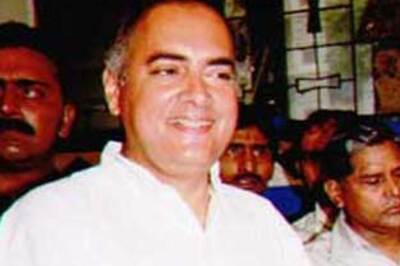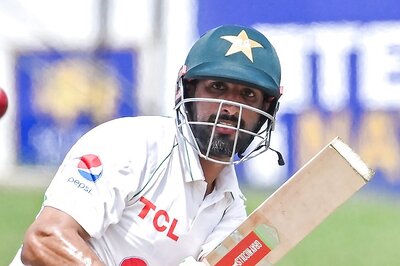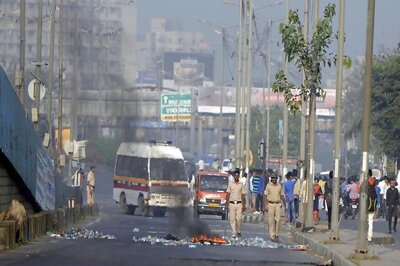
views
The mercury crossed the 45-degree mark on Thursday leaving several places across India to swelter under the grip of a scorching heatwave. As per data, since the onset of March, India experienced 26 heatwave days and as many as four spells of heatwaves. To top it off, a prediction of the IMD further stated that the spell of heatwave will persist over northwest and central India for the next five days and over east India for the next three days.
“A rise of about two degrees Celsius in the maximum temperature (is) very likely over most parts of northwest India during the next two days and no significant change thereafter,” the IMD noted.
Amid the growing concerns with respect to the intensifying heat with each passing day, here’s a guide to understanding the phenomenon and ways to keep oneself safe.
What is a heatwave?
The Indian Meteorological Department (IMD) describes a heatwave as a condition of air temperature which might prove to be fatal to human beings if exposed to it. Whereas, quantitatively, a heatwave is defined based on the temperature thresholds over a region in terms of actual temperature or its departure from normal. According to the weather department, the common period for the occurrence of the heatwave in India is from March to June. But in some rare cases, a heatwave can also occur in July. The peak month of the heatwave in the country is in May.
When does India declare a heatwave?
According to the Health Ministry, a heatwave is declared when the maximum temperature of a region reaches at least 40°C or more for plains, 37°C or more for coastal stations, and at least 30°C or more for hilly regions. For example, when departure from normal is 4.5°C to 6.4°C, it is called a heatwave whereas if the departure from normal is >6.4°C, then it is categorized under a severe heatwave.
How is heatwave monitored?
The intensity of monitoring the heatwave is vested with IMD. The IMD by virtue of its big network of surface observatories covering the entire country, measures meteorological parameters like temperature, relative humidity, pressure, etc.
“Based on daily maximum temperature station data, climatology of maximum temperature is prepared for the period 1981-2010 to find out the normal maximum temperature of the day for a particular station. Thereafter, IMD declared heatwave over the region as per its definition,” The IMD says.
Heatwave-hit states in India
Severe heat conditions have been consistently reported over large parts of India since the beginning of the summer season in March this year. Maximum temperatures in west Rajasthan and Vidarbha in Maharashtra have remained between 40 degrees and 45 degrees Celsius throughout the last two months.
A heatwave warning has been announced for Rajasthan, Delhi, Haryana, UP, and Odisha as parts of these states record temperatures above 45 degrees Celsius. The severe conditions are likely to persist till the first week of May after which chances of rain increase, IMD scientist RK Jenamani was quoted as saying by news agency ANI. The mercury maintained an upward trend in central India with temperatures in Madhya Pradesh and Uttar Pradesh crossing 45 degrees Celcius.
How does one guard themselves against the heatwave?
The Health Ministry recommends a list of measures you can take to stay safe in this period
1. Stay indoors and in shaded places.
2. Use an umbrella/hat/cap/towel when outside.
3. Wear thin loose cotton, light-coloured garments.
4. Drink water and salted drinks (lassi, lemon water, fruit juices, ORS) frequently. Eat fruits such as watermelon, cucumber, lemon, orange etc.
5. Take frequent cool baths and reduce room temperature. Use window shades/curtains, fan, cooler, air-conditioner, cross-ventilated room, sprinkle water, keep indoor plants, etc.
Those feeling uneasy or unwell, especially the elderly, children, pregnant women, the ones with pre-existing medical conditions, and outdoor workers have been advised to immediately shift to a cooler place, put on minimum clothing, be sponged with cold water and be transported to the nearest health facility.
Heatwave and Power Crisis: Double Whammy for India
Notably, the heat wave comes at a time when states and Union Territories (UTs) are facing a major power crisis. On Thursday, the country’s peak power demand met or the highest supply in a day touched the all-time high of 204.65 GW. Due to high demand and a deepening coal shortage, the Delhi government warned its residents of a possible setback in providing an uninterrupted electricity supply to Metro trains and hospitals. To the country’s horror, the India Meteorological Department (IMD) predicted the heatwave to continue, spurring high electricity demand.
More Heat for Coming Weeks
Weather forecast models indicate that parts of Pakistan and northwestern India could reach temperatures near 120 degrees F (50 degrees C) towards April end, May beginning. Major cities such as Delhi and Lahore are forecast to reach 113 degrees F (45 degrees C). Temperatures in major metropolitan areas can be further exacerbated by the urban heat island effect, increasing local temperatures a few degrees higher than the surrounding countryside, indicate reports.
This has led to the issuing of heatwave warnings for 10 major cities in India with some regional educational systems shutting down all schools for the next five days.
Read all the Latest India News here




















Comments
0 comment